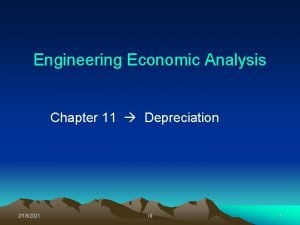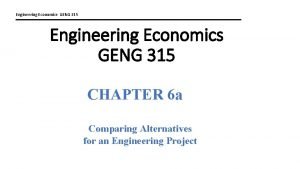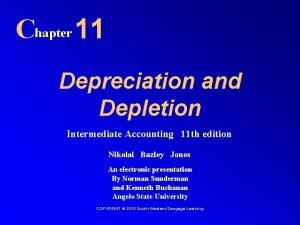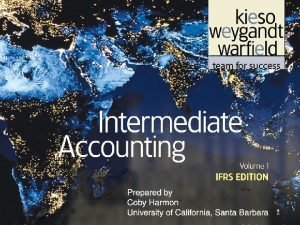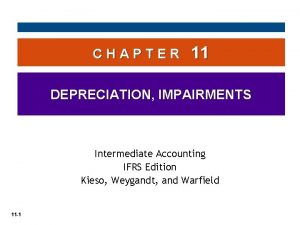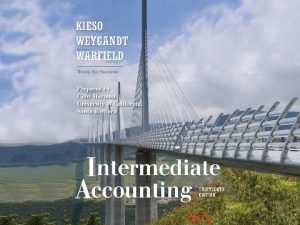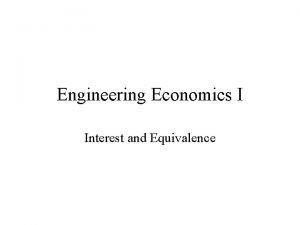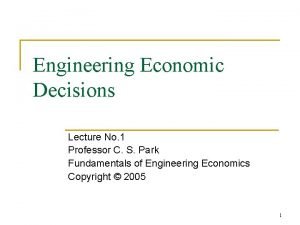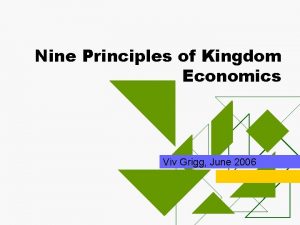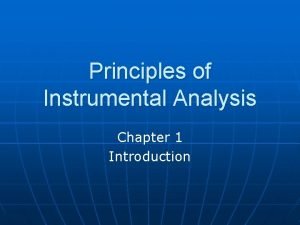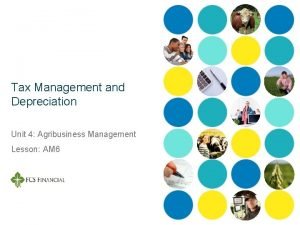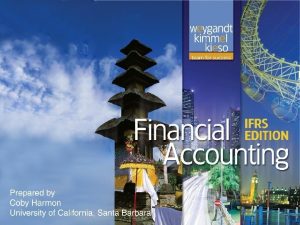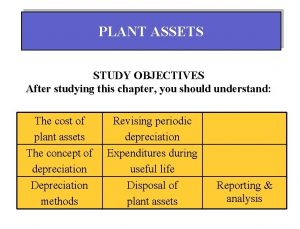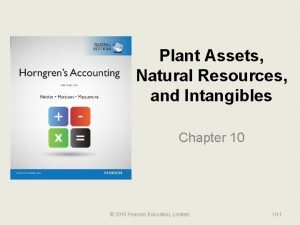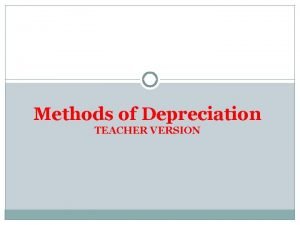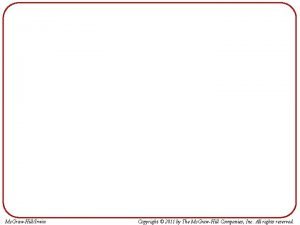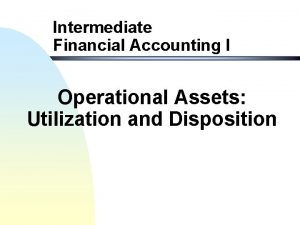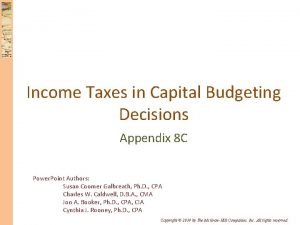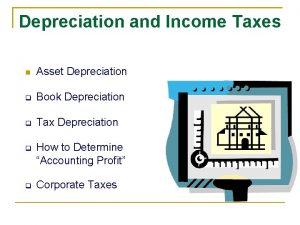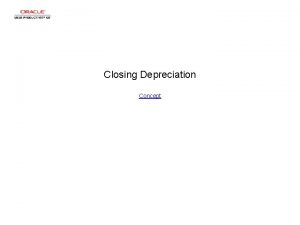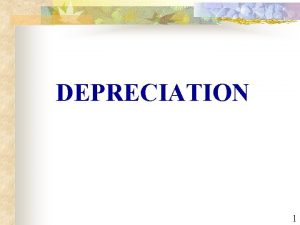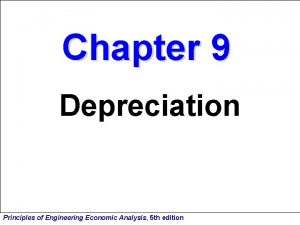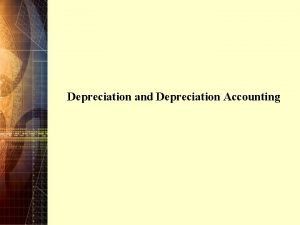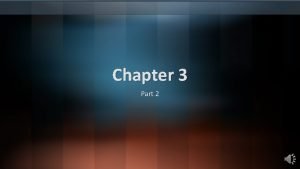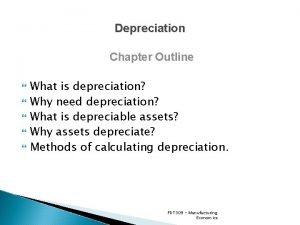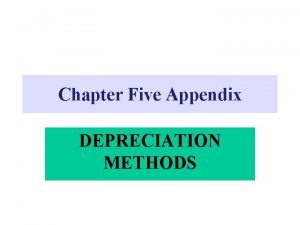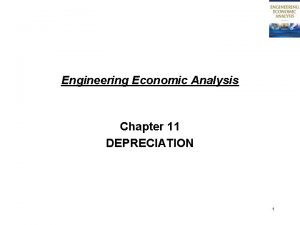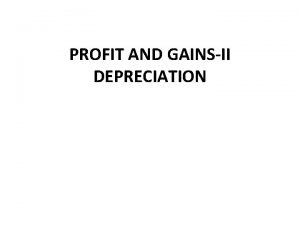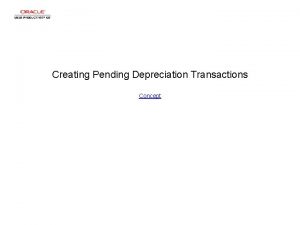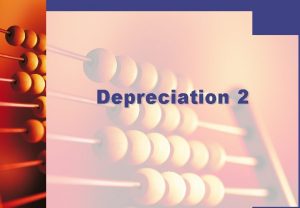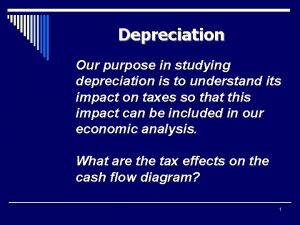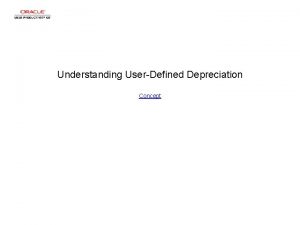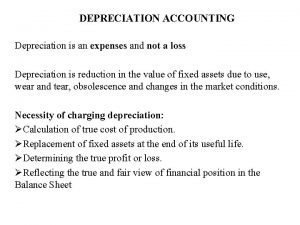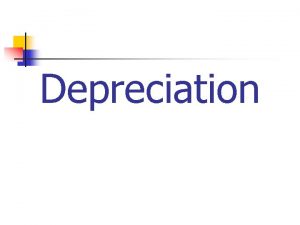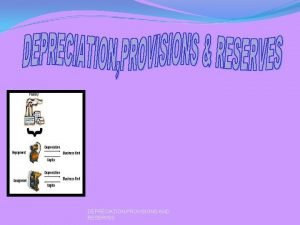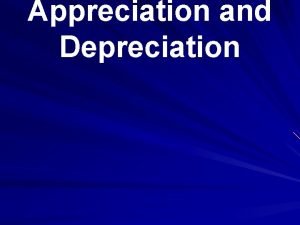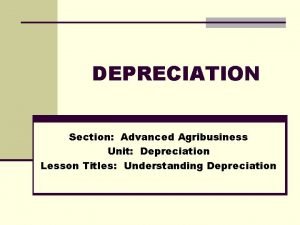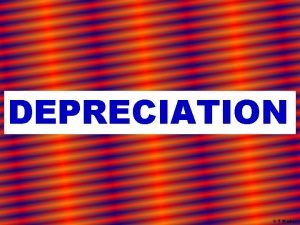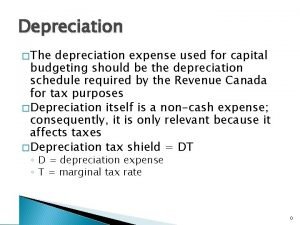Chapter 9 Depreciation Principles of Engineering Economic Analysis

























- Slides: 25

Chapter 9 Depreciation Principles of Engineering Economic Analysis, 5 th edition

Systematic Economic Analysis Technique 1. Identify the investment alternatives 2. Define the planning horizon 3. Specify the discount rate 4. Estimate the cash flows 5. Compare the alternatives 6. Perform supplementary analyses 7. Select the preferred investment Principles of Engineering Economic Analysis, 5 th edition

Questions about Depreciation • What is depreciation? Depreciation is a bookkeeping method reflecting the reduction in the value of an asset based on age, use, or output. • Is depreciation a cash flow? Depreciation is not a cash flow. • Why do we consider depreciation? Depreciation is of interest to us because of its impact on income taxes (which are cash flows!) Principles of Engineering Economic Analysis, 5 th edition

Engineers need to learn about depreciation because their design decisions can affect the way investments and annual operating costs are treated from an income tax perspective. Principles of Engineering Economic Analysis, 5 th edition

Depreciation Amount “The amount of the annual depreciation depends upon several factors, including (1) cost basis or investment in the property, (2) date placed in service, (3) property class or estimated useful life, (4) salvage value for certain methods, and (5) method of depreciation used. ” Department of Treasury Internal Revenue Service Principles of Engineering Economic Analysis, 5 th edition

Business expenditures are either expensed or depreciated. Expensing an expenditure is akin to depreciating it fully in the year in which it occurs. Expenditures for labor, materials, and energy are examples of items that are fully deducted from taxable income. Expenditures for production equipment, vehicles, and buildings, on the other hand, cannot be fully deducted from taxable income in the year in which they occur; instead, they must be spread out or distributed over some allowable recovery period. Principles of Engineering Economic Analysis, 5 th edition

Depreciable Assets Depreciable property (1) must be used in business or be held for the production of income, (2) must have a life longer than a year and be determinable, (3) must be something that wears out, decays, is consumed, becomes obsolete, or loses value from natural causes. Depreciable property may be tangible or intangible; tangible property may be real or personal. Land is “never” depreciable. Principles of Engineering Economic Analysis, 5 th edition

Depreciation Terminology cost basis: taxpayer’s investment (purchase price plus improvements, additions, and/or installation) – also called unadjusted basis depreciation allowance: the depreciation charge or deduction for a given year book value: cost basis less capital recovered, such as depreciation allowances – also called unrecovered investment, adjusted cost basis, and adjusted basis Principles of Engineering Economic Analysis, 5 th edition

Depreciation Terminology (cont’d) recovery period: time over which the cost basis can be recovered, keyed to 3, 5, 7, 10, 15, 20, 27. 5, or 31. 5 years, depending on type of property involved. salvage value: estimated market value at the end of the asset’s useful life: estimate of duration of use of the asset by the taxpayer Principles of Engineering Economic Analysis, 5 th edition

Straight-Line (SLN) Depreciation Let P = cost basis F = salvage value n = recovery period dt = depreciation allowance for year t Bt = book value at the end of year t dt = (P – F)/n =SLN(P, F, n) Bt = P - tdt Principles of Engineering Economic Analysis, 5 th edition

Example 9. 2 A surface mount placement machine is being purchased for $500, 000; it has an estimated useful life of 10 years and a salvage value of $50, 000 at that time. Determine the depreciation allowance for the 5 th year and the book value at the end of the 5 th year using SLN. P = $500, 000; F = $50, 000; n = 10; t = 5 d 5 = ($500, 000 - $50, 000)/10 = $45, 000 =SLN(500000, 50000, 10) = $45, 000 B 5 = $500, 000 – 5($45, 000) = $275, 000 Principles of Engineering Economic Analysis, 5 th edition

Example 9. 2 A surface mount placement machine is being purchased for $500, 000; it has an estimated useful life of 10 years and a salvage value of $50, 000 at that time. Determine the depreciation allowance for the 5 th year and the book value at the end of the 5 th year using SLN. P = $500, 000; F = $50, 000; n = 10; t = 5 d 5 = ($500, 000 - $50, 000)/10 = $45, 000 =SLN(500000, 50000, 10) = $45, 000 B 5 = $500, 000 – 5($45, 000) = $275, 000 Principles of Engineering Economic Analysis, 5 th edition Notice: no minus signs

Declining Balance (DB) Depreciation In addition to the previously defined notation, let p = declining balance percentage, rate, or fraction, e. g. 1. 5/n, 2/n* =-RATE(n, , -P, F) dt = p. P(1 – p)t-1 = (1 – p)dt-1 Bt = P(1 – p)t DB(cost, salvage, life, period, month) DDB(cost, salvage, life, period, month) VDB(cost, salvage, life, start_period, end_period, factor, no_switch) *When p = 2/n, called double declining balance (DDB) Principles of Engineering Economic Analysis, 5 th edition

Example 9. 3 A surface mount placement machine is being purchased for $500, 000; it has an estimated useful life of 10 years and a salvage value of $50, 000 at that time. Determine the depreciation allowance for the 5 th year and the book value at the end of the 5 th year using declining balance depreciation. P = $500, 000; F = $50, 000; n = 10; t = 5 p =-RATE(10, , -500000, 50000) = 20. 5672% d 5 = 0. 205672($500, 000)(1. 0 – 0. 205672)5 -1 = $40, 939. 70 =DB(500000, 50000, 10, 5) = $40, 937. 30 B 5 = $500, 000(1. 0 – 0. 205672)5 = $163, 840. 00 Principles of Engineering Economic Analysis, 5 th edition

Depreciation allowances and book values for Examples 9. 2 and 9. 4 d 5 = DDB(500000, 50000, 10, 5) = $40, 960. 00 d 5 = VDB(500000, 50000, 10, 4, 5, 2) = $40, 960. 00 Principles of Engineering Economic Analysis, 5 th edition

Switching from DDB to SLN with VDB Excel’s VDB worksheet function includes an optional feature: it can switch from using a specified declining balance rate to a straight-line rate when optimum to do so. But, what criterion is used to define optimum? Assuming a TVOM > 0%, since depreciation charges can be deducted from taxable income, ATPW is maximized when the PW of depreciation charges is maximized. Hence, we prefer to depreciate an asset sooner, rather than later. Therefore, accelerated depreciation methods are preferred to SLN depreciation, but only up to a point, and VDB determines that point. Principles of Engineering Economic Analysis, 5 th edition

Double Declining Balance Switching to Straight Line Depreciation The optimum time to switch from DDB to SLN is when, for the first time, the depreciation allowance with SLN is greater than the depreciation allowance with DDB allowance, i. e. , switch the first year for which (Bt-1 – F)/(n – t + 1) > p. Bt-1 where p = 2/n for DDB Principles of Engineering Economic Analysis, 5 th edition

Example 9. 4 For the surface mount placement machine, when should a switch from DDB to SLN occur? Switch at the smallest value of t for which (Bt-1 – F)/(n – t + 1) > p. Bt-1 Principles of Engineering Economic Analysis, 5 th edition

Principles of Engineering Economic Analysis, 5 th edition

(Bt-1 – F)/(n – t + 1) > p. Bt-1 $29, 428. 57 = ($256, 000 - $50, 000)/(10 – 3) Since $29, 428. 57 < $51, 200, don’t switch! Principles of Engineering Economic Analysis, 5 th edition

(Bt-1 – F)/(n – t + 1) > p. Bt-1 $16, 943. 04 = ($83, 886. 08 - $50, 000)/(10 – 8) Since $16, 943. 04 > $16, 777. 22, switch! Principles of Engineering Economic Analysis, 5 th edition

Sum of Years’ Digits (SYD) Depreciation Let P = cost basis F = salvage value n = recovery period dt = depreciation allowance for year t Bt = book value at the end of year t dt = 2(n – t + 1)(P – F)/[n(n + 1)] =SYD(cost, salvage, life, per) Bt = F + (P – F)(n – t + 1)/[n(n + 1)] Principles of Engineering Economic Analysis, 5 th edition

Example 9. A. 1 Calculate the SYD depreciation allowances and book values for the $500, 000 surface mount placement machine, including a useful life of 10 years and a salvage value of $50, 000. Principles of Engineering Economic Analysis, 5 th edition

Pit Stop #9—Avoid the Pot Holes 1. 2. 3. 4. 5. 6. 7. 8. 9. 10. True or False: Straight-line depreciation is the most popular depreciation method used in financial reporting. True or False: The Modified Accelerated Cost Recovery System is the most popular depreciation method used in computing corporate income tax liabilities. True or False: Based on maximizing the present worth of depreciation allowances, MACRS is preferred to SLN for recovery periods greater than 5 years. True or False: Accelerated depreciation plans were adopted after World War II to stimulate capital investment. True or False: Engineers seldom have an opportunity to influence the recovery period for expenditures. True or False: MACRS is equivalent to DDB, switching to SLN, with a midyear convention. True or False: The most popular variation of MACRS is MACRS-ADS. True or False: Sum-of-Years’-Digits depreciation is a popular depreciation method and is most often used to compute income tax liabilities. True or False: When given a choice of depreciation methods to use, choose the one that maximizes the present worth of book value. True or False: Sinking fund depreciation is the only depreciation method described in the book that is based on the time value of money. Principles of Engineering Economic Analysis, 5 th edition

Pit Stop #9—Avoid the Pot Holes 1. 2. 3. 4. 5. 6. 7. 8. 9. 10. True or False: Straight-line depreciation is the most popular depreciation method used in financial reporting. True or False: The Modified Accelerated Cost Recovery System is the most popular depreciation method used in computing corporate income tax liabilities. True or False: Based on maximizing the present worth of depreciation allowances, MACRS is preferred to SLN for recovery periods greater than 5 years. True or False: Accelerated depreciation plans were adopted after World War II to stimulate capital investment. True or False: Engineers seldom have an opportunity to influence the recovery period for expenditures. False True or False: MACRS is equivalent to DDB, switching to SLN, with a midyear convention. True or False: The most popular variation of MACRS is MACRS-ADS. False True or False: Sum-of-Years’-Digits depreciation is a popular depreciation method and is most often used to compute income tax liabilities. False True or False: When given a choice of depreciation methods to use, choose the one that maximizes the present worth of book value. False True or False: Sinking fund depreciation is the only depreciation method described in the book that is based on the time value of money. True Principles of Engineering Economic Analysis, 5 th edition
 Soyd depreciation
Soyd depreciation Engineering economic analysis procedure
Engineering economic analysis procedure Composite depreciation
Composite depreciation Accumulated depletion
Accumulated depletion Chapter 11 intermediate accounting
Chapter 11 intermediate accounting Chapter 11 depreciation
Chapter 11 depreciation Economic growth vs economic development
Economic growth vs economic development Economic growth vs economic development
Economic growth vs economic development Economics unit 1 lesson 2 difficult choices
Economics unit 1 lesson 2 difficult choices Chapter 3 political and economic analysis
Chapter 3 political and economic analysis Chapter 3 political and economic analysis
Chapter 3 political and economic analysis Capitalized cost formula engineering economics
Capitalized cost formula engineering economics Engineering economic decisions
Engineering economic decisions Kingdom economic principles
Kingdom economic principles Principles of instrumental analysis chapter 1 problem 1qp
Principles of instrumental analysis chapter 1 problem 1qp Macrs depreciation formula
Macrs depreciation formula Units-of-activity method of depreciation
Units-of-activity method of depreciation Double declining formula
Double declining formula Straight line method depreciation
Straight line method depreciation Isolux diagram for finding luminance on road surface
Isolux diagram for finding luminance on road surface Double declining method depreciation
Double declining method depreciation Double declining method depreciation
Double declining method depreciation Macrs 200% declining balance
Macrs 200% declining balance Tax shield
Tax shield Deemed depreciation fbt
Deemed depreciation fbt Written down value method
Written down value method
